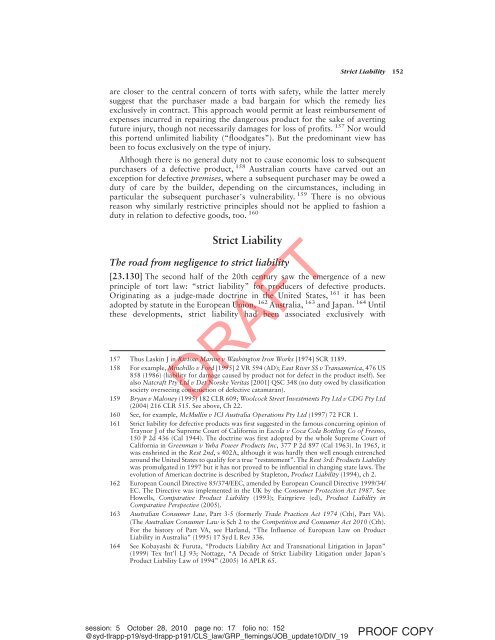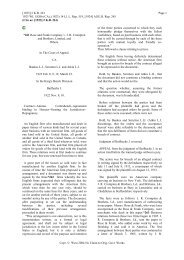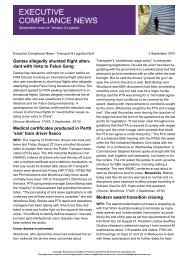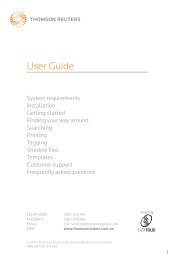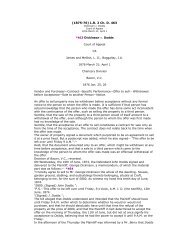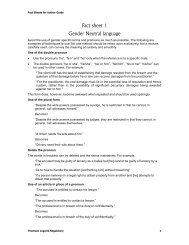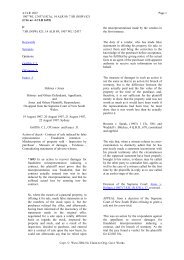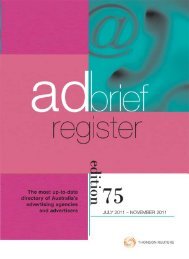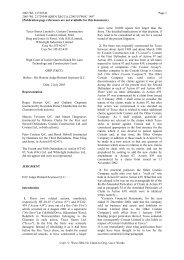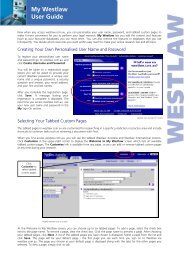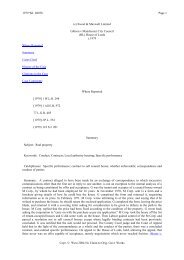Chapter 23: Product Liability - Thomson Reuters
Chapter 23: Product Liability - Thomson Reuters
Chapter 23: Product Liability - Thomson Reuters
You also want an ePaper? Increase the reach of your titles
YUMPU automatically turns print PDFs into web optimized ePapers that Google loves.
Strict <strong>Liability</strong> 152are closer to the central concern of torts with safety, while the latter merelysuggest that the purchaser made a bad bargain for which the remedy liesexclusively in contract. This approach would permit at least reimbursement ofexpenses incurred in repairing the dangerous product for the sake of avertingfuture injury, though not necessarily damages for loss of profits. 157 Nor wouldthis portend unlimited liability (“floodgates”). But the predominant view hasbeen to focus exclusively on the type of injury.Although there is no general duty not to cause economic loss to subsequentpurchasers of a defective product, 158 Australian courts have carved out anexception for defective premises, where a subsequent purchaser may be owed aduty of care by the builder, depending on the circumstances, including inparticular the subsequent purchaser’s vulnerability. 159 There is no obviousreason why similarly restrictive principles should not be applied to fashion aduty in relation to defective goods, too. 160Strict <strong>Liability</strong>The road from negligence to strict liability[<strong>23</strong>.130] The second half of the 20th century saw the emergence of a newprinciple of tort law: “strict liability” for producers of defective products.Originating as a judge-made doctrine in the United States, 161 it has beenadopted by statute in the European Union, 162 Australia, 163 and Japan. 164 Untilthese developments, strict liability had been associated exclusively with157 Thus Laskin J in Rivtow Marine v Washington Iron Works [1974] SCR 1189.158 For example,MinchillovFord [1995] 2 VR 594 (AD);EastRiverSSvTransamerica, 476 US858 (1986) (liability for damage caused by product not for defect in the product itself). Seealso Natcraft Pty Ltd v Det Norske Veritas [2001] QSC 348 (no duty owed by classificationsociety overseeing construction of defective catamaran).159 BryanvMaloney (1995) 182 CLR 609;WoolcockStreetInvestmentsPtyLtdvCDGPtyLtd(2004) 216 CLR 515. See above, Ch 22.160 See, for example, McMullin v ICIAustralia Operations Pty Ltd (1997) 72 FCR 1.161 Strict liability for defective products was first suggested in the famous concurring opinion ofTraynor J of the Supreme Court of California in Escola v Coca Cola Bottling Co of Fresno,150 P 2d 436 (Cal 1944). The doctrine was first adopted by the whole Supreme Court ofCalifornia in Greenman v Yuba Power <strong>Product</strong>s Inc, 377 P 2d 897 (Cal 1963). In 1965, itwas enshrined in the Rest 2nd, s 402A, although it was hardly then well enough entrenchedaround the United States to qualify for a true “restatement”. TheRest3rd:<strong>Product</strong>s<strong>Liability</strong>was promulgated in 1997 but it has not proved to be influential in changing state laws. Theevolution of American doctrine is described by Stapleton, <strong>Product</strong> <strong>Liability</strong> (1994), ch 2.162 European Council Directive 85/374/EEC, amended by European Council Directive 1999/34/EC. The Directive was implemented in the UK by the Consumer Protection Act 1987. SeeHowells, Comparative <strong>Product</strong> <strong>Liability</strong> (1993); Fairgrieve (ed), <strong>Product</strong> <strong>Liability</strong> inComparative Perspective (2005).163 Australian Consumer Law, Part 3-5 (formerly Trade Practices Act 1974 (Cth), Part VA).(The Australian Consumer Law is Sch 2 to the Competition and ConsumerAct 2010 (Cth).For the history of Part VA, see Harland, “The Influence of European Law on <strong>Product</strong><strong>Liability</strong> in Australia” (1995) 17 Syd L Rev 336.164 See Kobayashi & Furuta, “<strong>Product</strong>s <strong>Liability</strong> Act and Transnational Litigation in Japan”(1999) Tex Int’l LJ 93; Nottage, “A Decade of Strict <strong>Liability</strong> Litigation under Japan’s<strong>Product</strong> <strong>Liability</strong> Law of 1994” (2005) 16 APLR 65.DRAFTsession: 5 October 28, 2010 page no: 17 folio no: 152@syd-tlrapp-p19/syd-tlrapp-p191/CLS_law/GRP_flemings/JOB_update10/DIV_19PROOF COPY


